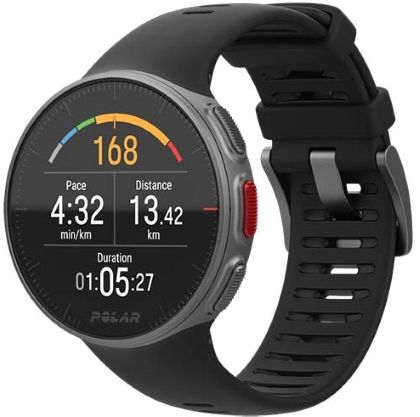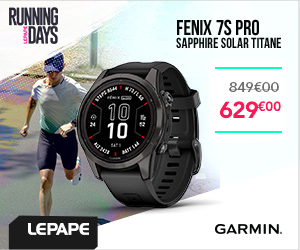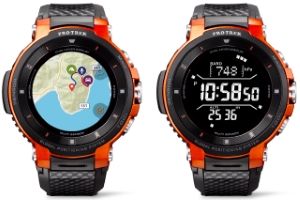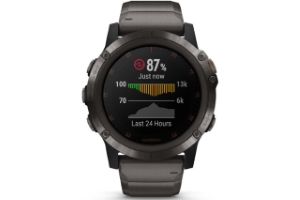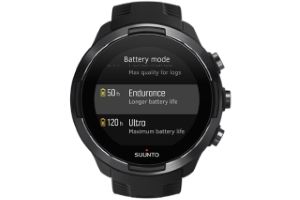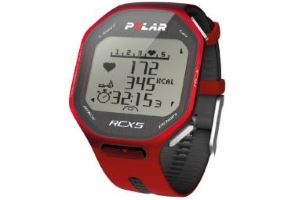Buy Polar Vantage V
Replacing the Polar V800, the Vantage V is a Premium multi-sport watch that offers features to help athletes maximize their performance. It has 130 sports profiles and is particularly well suited to triathlon practice. Its state-of-the-art optical heart rate sensor has 9 LEDs and 4 sensors for more reliable measurements (the interface even corrects inconsistencies during data processing) and operation in water. It is the first watch to offer instantaneous power measurement without an external sensor. The athlete support features offered by this model are exceptional. In particular, it offers 2 new functions, Training Load Pro& trade; and Recovery Pro& trade;, powerful tools that allow athletes to analyse the effects of a sports outing on different parts of the body and to dose their training in an optimal way.
Discover our detailed review and opinion on this amazing watch, but some of its features need to be improved.
Features of the Polar Vantage V
66 g
Dimensions
46 x 46 mm x 13 mm
Screen
Color, tactile, 240 x 240 px
Autonomy
40 h in GPS mode, 30 days in watch mode
GPS
GPS and GLONASS
Multisports
Yes, with transition between activities
Recommended activities
Triathlon, swimming, running, cycling, 130 sports profils
Connectivity
iPhone, Android, PC, Mac. Bluetooth wireless data transfer.
Cardio-frequency meter
Yes, cardio optics on the wrist
Topographic maps
No
No
Payment system
No
Telephony / 4G
No
Barometric altimeter
Yes
Barometer
Yes
Compass
No
Thermometer
No
Weather
No
Waterproof
3 ATM (30 m), suitable for swimming
Other
Power measurement, underwater and bicycle cardio optics, advanced performance analysis tools, 130 sports, activity monitoring
Detailed overview of the Polar Vantage V, the watch for demanding athletes and pros
For whom is the Polar Vantage V?
The Vantage V is a multi-sport and triathlon watch that also monitors activity 24 hours a day. It is intended for demanding athletes who are looking for advanced performance analysis functions and training tools. High level athletes, professionals, amateurs looking to train like the pros or fans of statistics and analysis will find their happiness there.
This new model replaces the Polar V800 with new features and especially interesting innovations that we describe below.
It should be noted that some functions of the V800 have not been maintained on the Vantage V or will only be offered later by updates of the watch software. We discuss this later in this article.
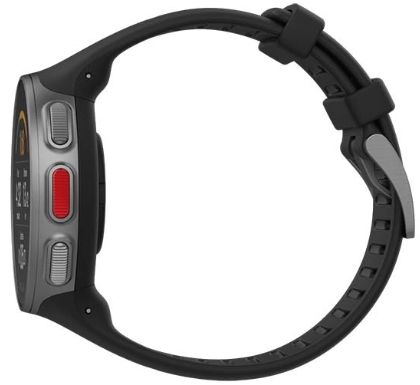
Design
The Vantage V is a watch with a simple design, in a stainless steel case and, new to Polar, with a round display. Some may not like it, but for others it is rather good news. Square screens can cause discomfort during wrist movements.
Polar offers a 240 x 240 pixel color touch screen for this model, like the Fenix 5, which is a nice improvement compared to the V800 (128 x 128 pixels). The touch screen can be used in clock mode (it is disabled during training). Note that the buttons must be used in addition to the touch.
The Vantage V is a comfortable watch to wear despite its weight of 66 g (a little higher than ultra-light watches but still 20 g lighter than a Fenix 5 Plus or Suunto 9). Its strap is not interchangeable (unlike the Vantage M), which is a bit of a pity, especially for a watch designed to be worn on a daily basis for activity monitoring.
An innovative optical cardio that works for interval training and underwater
Remember that Polar (short for Polar Electro Oy) is the inventor of the first wireless cardio-frequency meter. After a first monitor to take the pulse from a finger, Polar released its first cardio watch model in 1982! In 1995, the Finnish firm went further by measuring the variability of heart rate, a data that allows, among other things, to estimate the fitness level. For a long time, Polar has remained the reference for cardio-frequency watches and the use of the pulse for sportsmen and women.
The introduction of optical heart rate sensors on the wrist is a great innovation and Polar was not to be outdone by launching its first model equipped with such a sensor in 2015. With the Polar Vantage, the manufacturer is taking a new step forward by offering an innovative optical monitor with sensors for greater reliability and possible operation in adverse conditions, especially underwater.
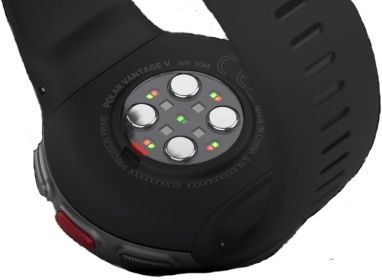
The optical sensor of the Vantage V consists of 9 LEDs of different wavelengths (red and green colours) and 4 light sensors, all designed to make measurements more reliable. In addition to this, 4 electrodes have been added to ensure that the sensors are in good contact with the skin. External light is the largest parasitic source of optical heart rate monitors.
In addition to these improvements, Polar corrects records to eliminate inconsistencies. For example, if a measurement indicates 160 bpm while the 2 surrounding measurements indicate a frequency of 140 bpm, the 160 bpm measurement will be considered as parasitic and eliminated.
Thanks to these improvements, the Vantage's optical cardio works in water, which is a first. Triathletes and swimmers will therefore be able to benefit from more complete measures (calories burned, etc.) without having to wear a chest belt. Measurements can also be used in fractionated training, where most other cardio optic watches fail to provide consistent measurements due to too fast pulse variations. Cyclists will also appreciate it, as optical cardio is generally not very suitable for cycling.
Overall, tests carried out on the Vantage V show good reliability and consistency of measurements for swimming, running and cycling, but users' opinions differ (see our opinion below). However, the chest belt remains the best option for reliable measurements. Polar also offers an optional H10 belt with the watch, which is also essential for performing the orthostatic tests offered by the Vantage.
Power measurement without external sensor: for a more targeted training
Also new on this model, a power sensor on the wrist evaluates the instantaneous power developed during the run. The particularity here is that it does not require any external sensors (Stryd, footpod, etc.).
Why use power instead of heart rate to train? Heart rate has long been used as an indicator of the level of effort. Hence its use to target training. In fact, power is a more interesting indicator than pulse measurement because it perfectly reflects the effort produced by the athlete while heart rate is influenced by other parameters (warm-up level, training level, stress, diet, fatigue, etc.). In addition, heart rate does not react instantly to changes in rhythm or load. In the case of acceleration, for example, the heart takes a certain amount of time to increase in frequency and the maximum reached depends on the previous heating. The instantaneous power, on the other hand, is a function of the intensity of the effort (power = force x speed). It is therefore much more suitable for training.
However, estimating the power developed is not an easy task since it would be necessary to be able to measure the force exerted by the runner but also take into account the running conditions: type of terrain (running in sand is not the same as running on tarmac!), weather conditions (rain, wind, etc.), slope, etc.
To estimate power without using a sensor, Polar is based on the energy expended by the runner over a short period of time. Kinetic energy (proportional to the rider's mass and speed, i.e. 1/2 mv2) and potential energy (proportional to the rider's mass and altitude difference, i.e. mh) are thus taken into account. The power developed is all the higher as the athlete weighs heavy, runs fast and climbs high.
Measurements are made using GPS (speed, distance covered), accelerometer (accelerations, decelerations) and barometric altimeter (measurement of the altitude difference covered).
The athlete can thus train from a power objective (rather than target heart rate areas), for example for the fractionated. Polar also uses power in its Training Load Pro function to evaluate the load that training exerts on the muscular system.
Advanced training functions. New Training Load Pro and Recovery Pro functions
In addition to the Polar functions offered on the V800, such as the Running Index (evaluation of the VO2max), training effectiveness (impact of a session on training), orthostatic test (recovery evaluation), Running Programs (customized training programs to prepare a race: 5 km, 10 km, half marathon or marathon), Polar offers two new functions on its Vantage V: Training Load Pro and Recovery Pro.
These highly sophisticated functions monitor your training load and recovery in the short and long term and help you adjust your training accordingly. The idea is to optimize your work and reduce the risk of injury and overtraining. The watch takes into account your physical stress but also the stress of daily life to advise you as best as possible
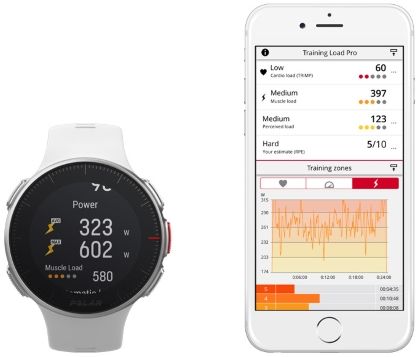
- Training Load Pro& trade; allows you to quantify the load of a workout on the cardiovascular system and muscles. This tool also takes into account the athlete's feelings. It measures the heart load (the load on the body, measured by the heart rate meter), the muscle load (the load on the muscles). It is evaluated by measuring the power developed) and the athlete's feeling (to be entered in the interface). This function allows you to evaluate the impact of training on your body (the watch gives a numerical score, a verbal report and a visual scale for each training load) and adjust the sessions accordingly.
- Recovery Pro& trade; allows you to know how your body recovers from stress and advises you to avoid overtraining or injuries. The recovery measurement is performed by an orthostatic test of a few minutes at rest to be done 3 times a week (requires the Polar H10 belt). The watch provides recommendations for the activity you can undertake.
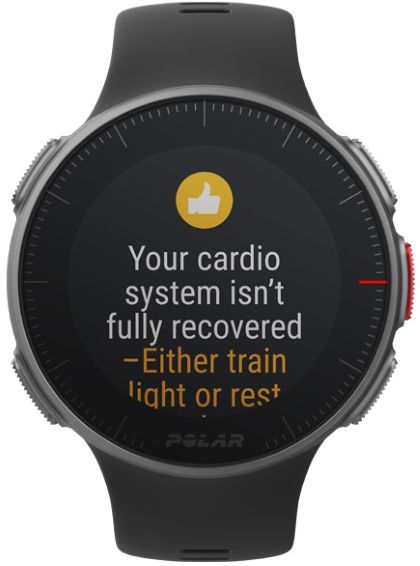
Sensors
The Vantage V has a GPS, barometric altimeter, accelerometer, cardio optic on the wrist. It is compatible with many external Bluetooth sensors, including: cadence, power, speed (cycling), cadence, stride (running), cardio belt.
The activity tracking function (tracker)
The Vantage V has an activity tracker on board to track your activity 24 hours a day: number of steps, distance covered, calories burned, sleep analysis. For the latter, the Polar Sleep function uses wrist movements to calculate the duration and quality of sleep. The optical sensor is not used (unlike other cardio watches or activity bracelets which use it to further analyze sleep phases). The watch issues inactivity alerts and informs its user about the effectiveness of its activity.
Connected functions: very limited for the moment
Most current cardio watches offer connected functions that allow you to at least be notified of calls, emails and SMS (Smart notifications) or to control the music on your smartphone, access the agenda, answer with predefined messages, control a VIRB camera and more. But for this new Polar model, no Smart notifications for the moment! However, these functions are expected to be added in the first quarter of 2019.
In the meantime, the watch allows you to connect to the Polar ecosystem for data transfer from the watch or to the watch (polar Flow interface) or for synchronization with third-party services such as TrainingPeaks, Strava, Apple Health Kit, Google Fit, MyFitnessPal.
Autonomy: impressive!
Polar announces the impressive 40 hours of battery life for its Vantage V (30 hours for the Vantage M) for use with GPS and recording every second! In comparison, the Garmin Fenix 5 only reaches 18 hours (32 hours for the Fenix 5X Plus) and the Suunto 9 Baro 25 hours.
The Vantage does not offer a power-saving mode, which is unfortunate for all those who make very long trips, especially since the watch cannot be charged in recording mode. For a record autonomy without altering the accuracy of the measurements too much, the Suunto 9 remains currently (in 2018) the reference.
Differences between Vantage M and Vantage V
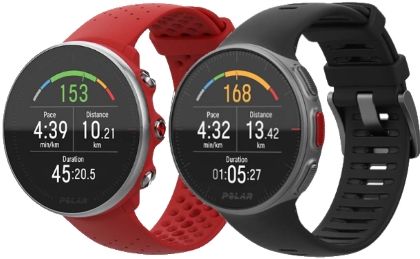
Polar has released the Polar Vantage M and Polar Vantage V, two sports watches that are aimed at a different audience. Indeed, the two do not have the same objective at all.
The Vantage V is a Premium watch for athletes looking for performance and training optimization. It is adapted to triathlon practice. It offers advanced functions that do not necessarily belong with amateur or occasional athletes.
The Vantage M is a complete multi-sport watch that is more running oriented. It is intended for athletes who like statistics and analysis of their exit to improve, avoid overtraining, improve their performance. It is equipped with Polar's brand new optical cardio (like the Vantage V) but is lighter in terms of hardware and features. Among the differences are:
- No touch screen
- A slightly lower autonomy but still excellent (30 h instead of 40 h)
- Lighter (45 g instead of 66 g)
- No barometric altimeter
- No measurement of the instantaneous power
- No Recovery Pro function (but it offers the Training Load Pro function)
- Not suitable for triathlon practice
- No interchangeable strap (unlike the Vantage V)
Our opinion: should you buy the Polar Vantage V?
The Polar Vantage V seems at first sight very attractive for its revolutionary optical cardio and innovative wrist-power sensor. Its training analysis functions are very advanced and complete. Polar also enjoys a high reputation for the quality of its heart rate measurements and operations. The firm has been a pioneer in this field and continues to convince the market for the reliability of its data. The Vantage V caught our attention for this. We also appreciated the watch's sober design, its comfortable fit on the wrist (you can't feel it) and its impressive autonomy.
Now, a number of points remain disappointing not only on paper (specifications) but also in practice. While several tests published on the Internet show good results, user opinions remain mixed regarding the quality of GPS and cardio optic data on the wrist. In addition, some of the features found on the V800 and yet very useful have disappeared on the Vantage V ! Polar will bring updates in the coming months but some functions will definitely no longer be supported, too bad. The point below.
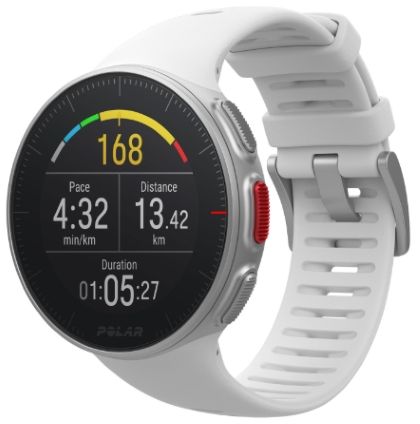
Design and characteristics: rather satisfactory
We liked the new design proposed by Polar, the watch and its discreet and round shape that was not felt when the wrist was moved.
The touch screen is appreciable even if the fluidity of the display still needs to be improved. The reading is comfortable except for the small size of some data (not very practical to read when you are in motion) and a weak display in the sun. The lighting of the lift at night is also a little dim. It's a shame that Polar doesn't offer watchfaces.
Vibration alerts are not very powerful but this can be a positive point for some people.
Finally, one wonders why the bracelet is not interchangeable when it is on the Polar Vantage M! This inconsistency is all the more surprising as the watch has been designed to be worn on a daily basis (sport and city).
Features: good tools, some disappointments but new features to come
The watch offers new and innovative functions (power measurement without external sensor, Training Load Pro and Recovery Pro) that seem very complete and will delight athletes looking for detailed analyses of their training. These functions are a valuable aid to athletes who want to optimize their training while taking care of their body.
On the other hand, the watch has lost a number of functions that are present on the Polar V800. Polar will offer some of these functions in future updates of the watch software, but others will not be implemented in principle and that is a pity.
Some of the features on the V800 that have been removed from the Vantage include ZoneLock (training targets based on predefined values of HR, speed, pace or power), Jump Test (evaluation of muscle strength, power and leg muscle fatigue) and energy saving mode. The latter has however become today one of the most important characteristics of ultratrail and ultramarathon runners! Especially since the Vantage cannot be recharged during an outing!
Functions that are expected to be implemented in the near future include activity alerts, route import, Strava Live segments, Polar Fitness Test, route guide or tracking (GPS track) and return to start point function, timer for split, classic connected functions (smart notifications, Smartphone music control, etc). In short, essential functions today. Fortunately, Polar plans to introduce them in the coming months!
Moreover, there are no mp3 players, maps, payment systems or other functions on this model that are more or less useful but that attract new users. Polar prefers to focus on purely sporting functions. It must also be said that the manufacturer designs everything himself, which makes it difficult to upgrade against the competition. A Bluetooth wireless music player would be appreciated by many runners who like to listen to music during their sport but don't want to carry a smartphone.
The quality of cardio optic measurements: it all depends on the conditions
While cardio optics is a great innovation that looks promising on paper, the opinions of the first users of the Vantage seem less convincing. Despite the increase in the number of LEDs, the 2 wavelengths to better reach the different layers of the epidermis and the electrodes to detect poor measuring conditions, the readings observed sometimes deviate significantly from reality.
Remember that an optical heart rate monitor on the wrist (detection of blood movement in the veins) can never match a chest belt (measurement of electrical impulses). The quality of the measurements depends on a number of parameters such as skin type, hairiness, blood circulation at the sensor, the correct position of the cardio on the wrist, the degree of humidity, the amount of perspiration, the temperature of the wrist, etc. Satisfactory measurements in one user may not be satisfactory in another. This is why Polar requires the use of a belt for orthostatic testing.
The Vantage's optical sensor nevertheless has the advantage of operating in difficult conditions where most other watches fail: fractionated, aquatic environment or cycling for example. For reliable results, however, it is better to use a belt.
The GPS sensor: to be reviewed?
The quality of the Vantage's GPS measurements seems correct even if the readings are not always in line with those of other competing watches. Some users even report significant discrepancies. This remains to be confirmed because the accuracy of GPS chips today is 5 to 10 m, or even more depending on the conditions (signal quality in particular). The size of the antenna plays an important role in this. With such a margin, it is therefore difficult to compare models and judge differences in position of a few meters. It is like using a 1 degree precision thermometer to measure and compare variations of 0.1 degree. It should be noted that in town or in the forest, the reception conditions are poor and it is the quality of the antenna that will make the difference between 2 watches, but also the satellite system (GLONASS, Galileo, etc.) and, let us not forget, the software using the data. Galileo offers greater accuracy but the Polar does not use this system for its Vantage.
The goal of GPS watch manufacturers is also to have the most energy-efficient GPS chips possible and this does not necessarily mean better accuracy, on the contrary. For the Vantage, Polar uses a Sony chip, which is certainly less energy consuming but less precise than the Sirf chip on board the Polar V800 (one of the most accurate and precise watches still today in terms of GPS measurements). It will still be a while before the next sports watches integrate the brand new GPS chip offered by Broadcom. It would have an accuracy of only a few centimetres (about 30 cm depending on the signal) and would consume half as much energy! An ideal candidate for a GPS mount!
Unlike its Polar V800, the degraded GPS mode (power save or Ultra mode) is no longer available! This limitation will undoubtedly be unacceptable to fans of so-called "ultra" races. Polar doesn't seem to be sensitive to it, too bad....
Another point, which is not directly related to GPS, is the barometric altimeter. As its name suggests, it uses atmospheric pressure to estimate altitude. However, the Vantage does not allow the barometer to be calibrated. Polar probably has to use GPS for this calibration but as it is not ultra accurate in today's watches, the calibration is far from perfect and can vary greatly with changes in atmospheric pressure!
Upcoming improvements on the Vantage V
Polar announces some upcoming improvements on its watch. These functions seem essential to us and should logically have been delivered as soon as the model was released in October 2018. In addition, there will be patches for the functions already delivered. It is hoped to find, among other things, improvements in the use of data from the optical heart rate monitor and GPS.
For those who purchased the Vantage before these updates, simply update the watch software via the Polar interface.
- End 2018: timer (for the split), improvements/corrections to functions already delivered
- 1erquarter 2019 : Smart notifications, route import and route guide, return to the starting point, navigation to waypoints for imported routes
- During 2019 : Strava Live Segments, Fitness Test, Inactivity Alerts
Conclusion
The Vantage V targets a very sporty public who love data and analysis and who are looking for concrete tools to get to know each other better, optimize their performance and progress. We are a little disappointed by the vagaries of cardio optics and the accuracy of GPS, which is lower, a priori, than the V800, which raises questions about the interest of this new model. Fortunately, the wrist pulse measurement, Training load Pro and Recovery Pro functions, power measurement and activity monitoring give this watch a new lease of life that will interest a targeted audience.
In view of the Vantage V tests and the assessments of the first buyers, this cardio watch does not yet seem completely ripe to us. Polar probably targeted the holidays to optimize sales. A risky bet that could well discourage some fans of the brand, especially since many have been waiting impatiently for this new model that has been awaited for years.
If you're looking for a multi-purpose watch that offers advanced sports features, mapping, a music player, the ability to pay for small purchases or various widgets, keep walking. The Vantage was not designed for this. Instead, turn to Garmin and its excellent Fenix 5 Plus or, for the look and less sporty use, to a Apple Watch 4. For runners and triathletes, the Garmin Fenix 935 remains a reference.
For advanced sports use oriented running, trail or hiking and a record range ideal for so-called "ultra" courses, we currently recommend the Suunto 9 Baro as an interesting alternative to the Polar Vantage V.
- Possible use of cardio optics for cycling, swimming and fractional activities
- Excellent autonomy
- Wrist power measurement without external sensor
- Extensive athlete support functions including Training Load Pro& trade; and Recovery Pro& trade;
- More navigation functions (route tracking, return to departure) (planned for 2019)
- An mp3 player
- Smart notifications (planned for 2019)
- Watchfaces
- An interchangeable bracelet
Price and availability
The Polar Vantage V has been available for sale since October 2018. It is available in 2 sizes and 3 colours (black, white and orange). It can be purchased in specialized stores and on the Internet. Discover it at our partners and enjoy our coupons.
Buy Polar Vantage V
Buy Polar Vantage M
These articles may also interest you
Casio Pro Trek WSD-F30 : la montre connectée pour les aventuriers
Avis sur la Suunto 9 : autonomie record et précision même sans GPS !
Meilleures montres GPS 2025 pour le triathlon
Meilleures montres cardio GPS 2025 pour la course à pied
Photo credit : Fotolia.com

